SAIL TRAINING
CYA INSTRUCTION
CHARTERS
ADVENTURE TRAVEL

TEL: (604) 689-1647
FAX: (604) 669-2888
TOLL FREE (800) 661-9133
WWW.SEABC.COM
EMAIL:bewley@seabc.com
SAIL TRAINING |
|
|
|
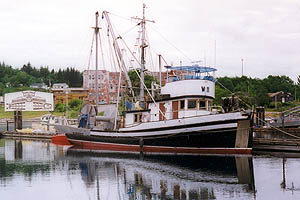 |
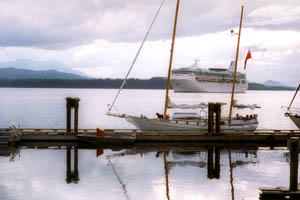 |
When one sails in to the 'new' harbour you're met by the clanging rigging from a fleet of seiners that stands out above the huge grey boulders of its breakwater .They provide shelter from the swells which roll down Queen Charlotte Strait in the prevailing North Westerlies. Sweeping out to one's left past the classic tin roofed sheds of bygone canneries, a mix of weathered buildings and piers stand with the ankles of their pilings awash in the gravelly shoreline. To the right as one walks ashore the eye is drawn to an eclectic display of imposing totem poles as they gaze out to sea from the grassy slope of the local burial ground. Fantastic in shape, design and colour they are the first of many features that will inspire awe and reverence in the visitor.
One can stroll along the waterfront with its classic board walks, sporting a variety of old cedar sided buildings from ship chandler to craft shop. Go inside and you'll find planked fir flooring, wood framed sash windows and wellworn counters installed long before the days of self service. The 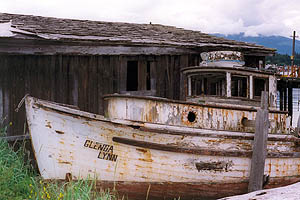 harbour is home to everything from state of the art aluminum seine fishing boats to the decaying hulks of funky home built sailing craft. Wafting in the light warn air a salty blend of tar, diesel, drying seaweed, percolating coffee and woodsmoke accompanies ones idle curiosity.
harbour is home to everything from state of the art aluminum seine fishing boats to the decaying hulks of funky home built sailing craft. Wafting in the light warn air a salty blend of tar, diesel, drying seaweed, percolating coffee and woodsmoke accompanies ones idle curiosity.
Walking onwards the shore has an attractive pebble beach with here and there the rotting remains of old seacraft long since run ashore and abandoned. Huge grey cedar logs in varying stages of decay litter the high water mark amidst an array of wild flowers, tall grasses, and lengths of brightly coloured poly prop rope and fishing net fragments. To westward the mountains of Vancouver Island dominate the skyline above the Nimpkish River on the opposite shore.
Passing the quaint and very photogenic little church of St Georges one moves on to what for many is the village's show piece attraction. The Umista cultural center and museum occupies one of two prominent buildings at the far end of the bay, its huge gable end resplendent in thunderbird and salmon motifs. Inside is housed one of the finest collections of artifacts demonstrating the historical and cultural significance of the potlatch. You will find a splendid display of masks , coppers, ceremonial objects and archival photographs. The story they tell is at once fascinating, compelling and thought provoking. There is a definite air of the sacred; the kind of atmosphere where you find yourself talking in whispers as if in one of the great European cathedrals.
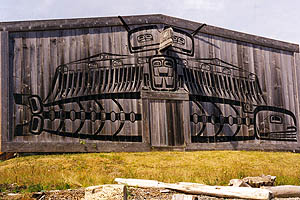 |
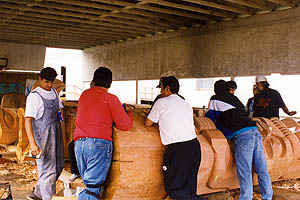 |
Outside again in the warm sunshine a team of carvers is chipping away at a new totem pole in the making. Forty feet long and with a diameter of four and a half feet it’s a substantial project for master and pupils. It’s a mere baby however when compared to the pole rising skyward a quarter of a mile away. At two hundred feet high it's billed as the tallest totem in the world and carved from bottom to top. How on earth did they manage to get it up there?
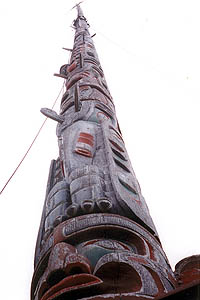 |
Next on the list is a trip to what used to be called Gator Gardens, but now renamed The Alert Bay Ecological Park. A steepish hike of three hundred feet or so up a pathway from the center of the village takes one to a plateau with fine views overlooking the water. Here one is rewarded by a most 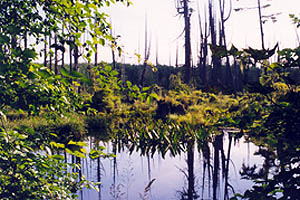 unusual vista after strolling through a perimeter of giant cedars.
unusual vista after strolling through a perimeter of giant cedars.
Stretching out for many acres is a scene one might expect to find in a showcase Florida swamp. A board walk leads the visitor through a delightful array of exotic plants and vegetation of every conceivable size and shape. The park is alive with bird life and presents a feast for the amateur ornithologist, botanist or photographer. Its well worth a little perspiration to get there and will set up your appetite nicely for lunch. I enjoyed the home style country cooking and friendly service at the centrally located Old Custom House Restaurant.
Round out your tour by examining some of the local craft work in the village shops. You'll find the quality and diversity of the paintings and carvings to be worthy of inspection. While unlikely to find another hidden masterpiece by Carr, you will hopefully have discovered a great deal more than you thought you might have when you set out. I did.
CTC
Bewley Sailing